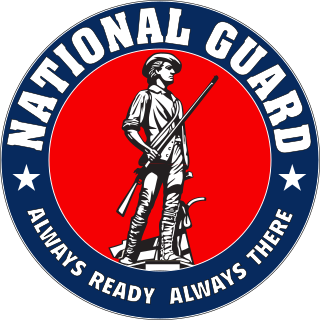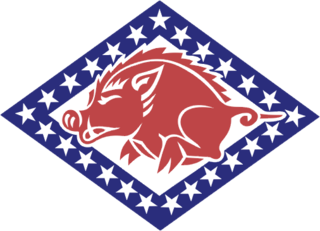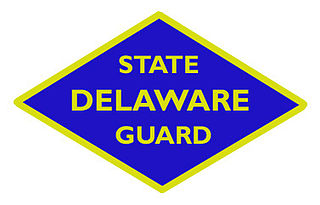
The National Guard is a state-based military force that becomes part of the reserve components of the United States Army and the United States Air Force when activated for federal missions. It is a military reserve force composed of National Guard military members or units of each state and the territories of Guam, the Virgin Islands, Puerto Rico, and the District of Columbia, for a total of 54 separate organizations. It is officially created under Congress's Article 1 Section 8 ability to 'raise and support armies'. All members of the National Guard are also members of the organized militia of the United States as defined by 10 U.S.C. § 246. National Guard units are under the dual control of the state governments and the federal government.

A naval militia in the United States is a reserve military organization administered under the authority of a state government. It is often composed of Navy, Marine Corps, and Coast Guard reservists, retirees and volunteers. They are distinguishable from the U.S. Coast Guard Auxiliary which is a federally chartered civilian volunteer component of the U.S. Coast Guard and falls under the command of the Commandant of the Coast Guard through the Chief Director of the Auxiliary, and the United States Maritime Service and United States Merchant Marine, both of which are federal maritime services.

The Virginia Defense Force (VDF) is the official state defense force of Virginia, one of the three components of Virginia's state military along with the Virginia National Guard which includes the Virginia Army National Guard, the Virginia Air National Guard, and the unorganized militia. As of 2019, the VDF has approximately 250 soldiers. The VDF is the descendant of the Virginia State Guard, the Virginia Regiment, and ultimately the Colonial Virginia militia of the Virginia Colony.

The Florida National Guard is the National Guard force of the state of Florida. It comprises the Florida Army National Guard and the Florida Air National Guard.

The Minnesota National Guard is the National Guard of the state of Minnesota, United States. It has more than 13,000 soldiers and airmen, serving in 61 communities across the state.

The Pennsylvania Army National Guard, abbreviated PAARNG, is part of the United States Army National Guard and is based in the U.S. Commonwealth of Pennsylvania. Together with the Pennsylvania Air National Guard, it is directed by the Pennsylvania Department of Military and Veterans Affairs. The PAARNG maintains 124 armories and is present in 87 communities across the Commonwealth.

The Texas State Guard (TXSG) is part of the state military force of Texas, and one of three branches of the Texas Military Forces. Along with the other two branches, the TXSG falls under the command of the Governor of Texas and is administered by the Adjutant General of Texas, an appointee of the Governor. The other two branches of the Texas Military Forces are the Texas Army National Guard and the Texas Air National Guard.

The Arkansas Army National Guard (ARARNG) is a component of the Arkansas National Guard and the United States National Guard. National coordination of various state National Guard units are maintained through the National Guard Bureau.

The Ohio Army National Guard is a part of the Ohio National Guard and the Army National Guard of the United States Army. It is also a component of the organized militia of the state of Ohio, which also includes the Ohio Naval Militia, the Ohio Military Reserve and the Ohio Air National Guard. The Ohio Army National Guard consists of a variety of combat, combat support, and combat service support units. As of September 2010, its end strength exceeded 11,400 soldiers. Its headquarters is the Beightler Armory in Columbus, Ohio. Many units conduct Annual Training at Camp Grayling, Michigan.

The South Carolina State Guard (SCSG) is the designated state defense force for the state of South Carolina.

The Washington State Guard is the state defense force of the U.S. state of Washington. It is an element of the state's military forces which also include the Washington Army National Guard and the Washington Air National Guard.

The Colorado National Guard consists of the Colorado Army National Guard and Colorado Air National Guard, forming the state of Colorado's component to the United States National Guard. Founded in 1860, the Colorado National Guard falls under the Colorado Department of Military and Veterans Affairs.

The Missouri State Defense Force (MSDF), formerly known as the Missouri Reserve Military Force, is the official state defense force of Missouri. As a state defense force, the MSDF is a reserve military force which serves parallel to the Missouri National Guard. As the MSDF falls solely under the command of the state of Missouri, it cannot be federalized or deployed outside the borders of Missouri, unlike the National Guard. Although the MSDF and the Missouri National Guard are separate organizations, the MSDF's primary scope is to work alongside the National Guard during stateside operations, or in lieu of the National Guard when the National Guard is deployed outside of Missouri. Along with the Missouri Army National Guard, the Missouri Air National Guard, and the Missouri Naval Militia, the Missouri State Defense Force is recognized under Missouri law as part of the organized militia of Missouri.

The Delaware State Guard is the currently inactive state defense force of the state of Delaware, which was active during both World War I and World War II. As the official militia of the state, the Delaware State Guard was created with the intent of acting as a stateside replacement for the Delaware National Guard while the National Guard units were deployed abroad.

The Louisiana State Guard (LSG) is the official state defense force of the state of Louisiana. The LSG was first created during World War II. As a state defense force, the LSG is a part of the state militia of Louisiana, and can serve as a stateside replacement of the Louisiana National Guard while the National Guard is deployed. Unlike the Louisiana National Guard, the Louisiana State Guard is solely under state control, and cannot be federalized or deployed outside of Louisiana, guaranteeing additional soldiers will always be available to the governor to deploy in response to crises.

The Maine State Guard was the state defense force of the state of Maine during World War I, World War II, and the Vietnam War. As a state defense force, the State Guard served as a stateside replacement for the Maine National Guard when the National Guard was federalized. Like the National Guard, the State Guard was a reserve military force composed of members who held full-time civilian jobs and periodically met for drills, unless called into active service by the governor. However, unlike the National Guard, as a state defense force, the Maine State Guard was solely a state military force, which was immune from federalization and could not be deployed outside the State of Maine.
The South Dakota State Guard is the currently inactive state defense force of South Dakota. The State Guard is recognized as a military force separate from the South Dakota National Guard. Unlike the National Guard, the State Guard is a purely state-level military force under the command of the Governor of South Dakota, and cannot be federalized or deployed outside the borders of the state. The South Dakota State Guard was active during World War I, World War II, and the Vietnam War and provided military protection to the state of South Dakota while the National Guard was in federal service.
The Iowa State Guard is the currently inactive state defense force of Iowa. The Iowa State Guard was organized during World War II in order to replace the Iowa National Guard which was federalized as a result of the war. The Iowa State Guard is recognized as a part of the organized militia of Iowa.
The New Jersey State Guard, previously known as the New Jersey State Militia, is the inactive state defense force of New Jersey, and is one of New Jersey's authorized military forces. The State Guard served as the stateside replacement for the New Jersey National Guard during World War I and World War II when the National Guard was deployed abroad.
The United States Guards (USG) was a lightly armed, all-infantry military force maintained by the United States from 1917 to 1919. Tasked with an internal security and territorial defense mission within the Zone of the Interior, it was used to protect critical infrastructure and suppress civil unrest during World War I. Though it successfully defended more than 300 strategic sites during its brief existence, its use as a provost force was marked by violent clashes and the liberal use of lethal force. During a deployment in Butte, Montana, the United States Guards was accused by Thomas Watt Gregory, the Attorney-General of the United States, of imposing a "reign of terror" upon the city.
















